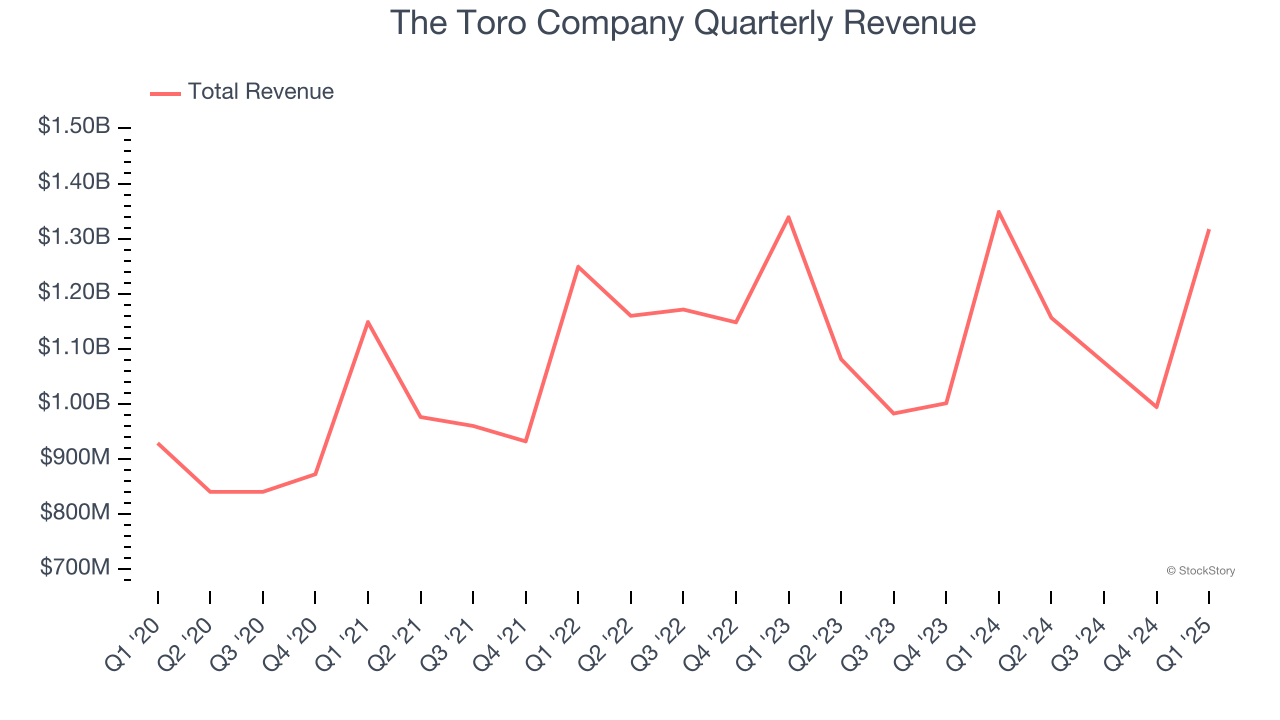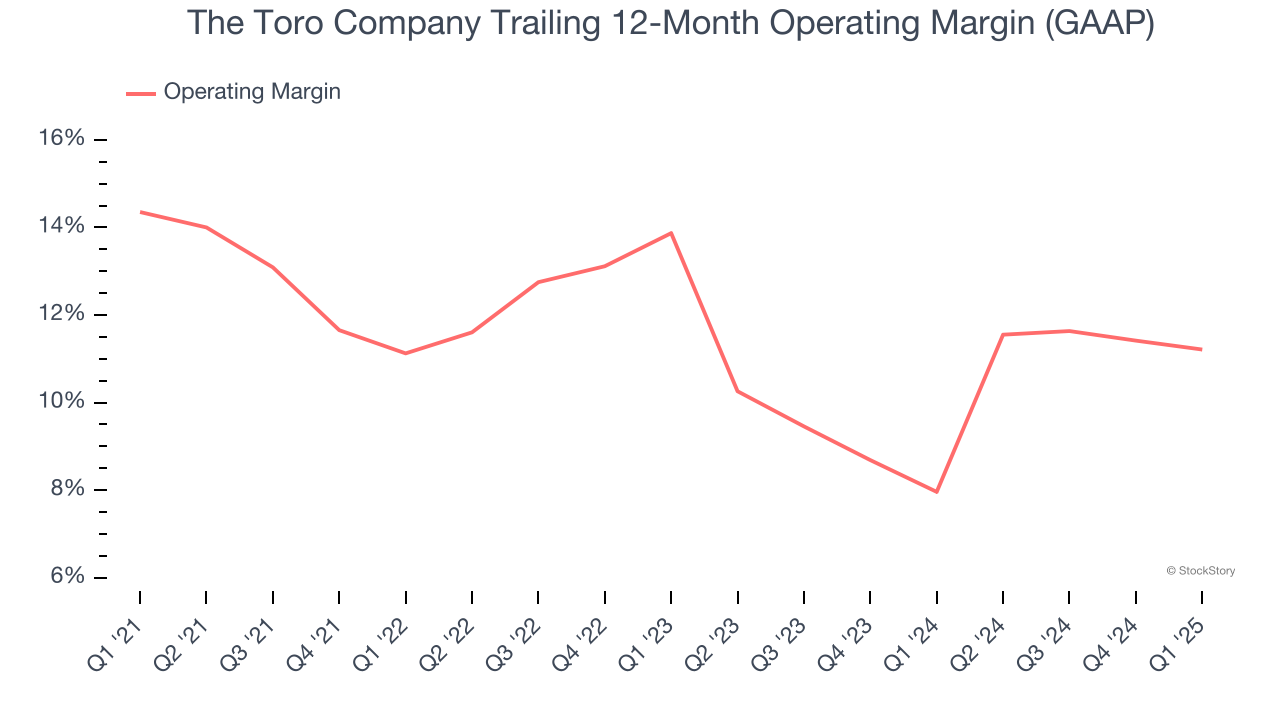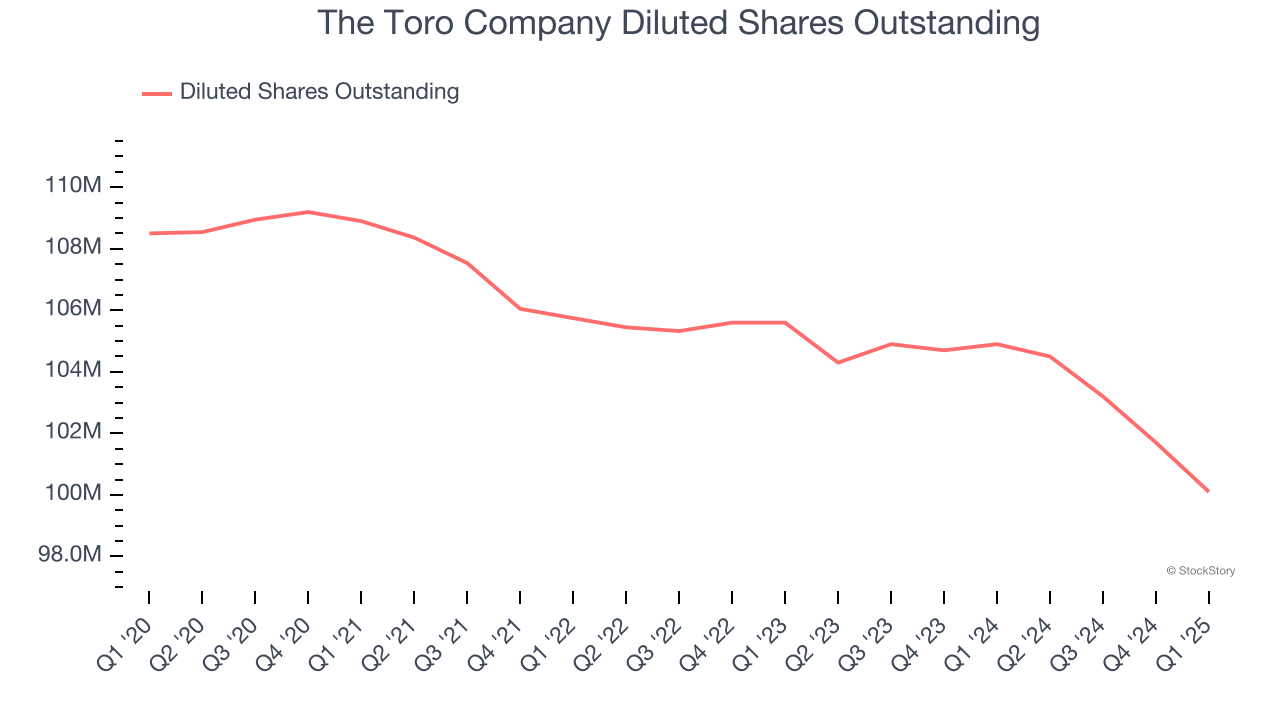
Outdoor equipment company Toro (NYSE: TTC) fell short of the market’s revenue expectations in Q1 CY2025, with sales falling 2.3% year on year to $1.32 billion. Its non-GAAP profit of $1.42 per share was 1.8% above analysts’ consensus estimates.
Is now the time to buy The Toro Company? Find out by accessing our full research report, it’s free.
The Toro Company (TTC) Q1 CY2025 Highlights:
- Revenue: $1.32 billion vs analyst estimates of $1.35 billion (2.3% year-on-year decline, 2.3% miss)
- Adjusted EPS: $1.42 vs analyst estimates of $1.40 (1.8% beat)
- Adjusted EBITDA: $196.1 million vs analyst estimates of $216.9 million (14.9% margin, 9.6% miss)
- Management lowered its full-year Adjusted EPS guidance to $4.23 at the midpoint, a 2.3% decrease
- Operating Margin: 13.3%, in line with the same quarter last year
- Free Cash Flow Margin: 11.6%, down from 15.3% in the same quarter last year
- Market Capitalization: $7.54 billion
“Our second-quarter results demonstrate the resilience and agility of The Toro Company and commitment of our dedicated employees and channel partners to deliver innovative solutions and exceptional service to meet our customers’ needs,” said Richard M. Olson, chairman and Chief Executive Officer.
Company Overview
Ceasing all production to support the war effort during World War II, Toro (NYSE: TTC) offers outdoor equipment for residential, commercial, and agricultural use.
Sales Growth
A company’s long-term sales performance can indicate its overall quality. Any business can put up a good quarter or two, but many enduring ones grow for years. Regrettably, The Toro Company’s sales grew at a mediocre 6.8% compounded annual growth rate over the last five years. This was below our standard for the industrials sector and is a rough starting point for our analysis.

Long-term growth is the most important, but within industrials, a half-decade historical view may miss new industry trends or demand cycles. The Toro Company’s performance shows it grew in the past but relinquished its gains over the last two years, as its revenue fell by 2.9% annually. 
We can dig further into the company’s revenue dynamics by analyzing its most important segments, Professional and Residential , which are 76.9% and 22.6% of revenue. Over the last two years, The Toro Company’s Professional revenue (sales to contractors) averaged 2.5% year-on-year declines while its Residential revenue (sales to homeowners) averaged 1.7% declines.
This quarter, The Toro Company missed Wall Street’s estimates and reported a rather uninspiring 2.3% year-on-year revenue decline, generating $1.32 billion of revenue.
Looking ahead, sell-side analysts expect revenue to grow 3.4% over the next 12 months. While this projection implies its newer products and services will spur better top-line performance, it is still below the sector average.
Here at StockStory, we certainly understand the potential of thematic investing. Diverse winners from Microsoft (MSFT) to Alphabet (GOOG), Coca-Cola (KO) to Monster Beverage (MNST) could all have been identified as promising growth stories with a megatrend driving the growth. So, in that spirit, we’ve identified a relatively under-the-radar profitable growth stock benefiting from the rise of AI, available to you FREE via this link.
Operating Margin
Operating margin is an important measure of profitability as it shows the portion of revenue left after accounting for all core expenses – everything from the cost of goods sold to advertising and wages. It’s also useful for comparing profitability across companies with different levels of debt and tax rates because it excludes interest and taxes.
The Toro Company has managed its cost base well over the last five years. It demonstrated solid profitability for an industrials business, producing an average operating margin of 11.7%. This result isn’t too surprising as its gross margin gives it a favorable starting point.
Analyzing the trend in its profitability, The Toro Company’s operating margin decreased by 3.1 percentage points over the last five years. This raises questions about the company’s expense base because its revenue growth should have given it leverage on its fixed costs, resulting in better economies of scale and profitability.

This quarter, The Toro Company generated an operating margin profit margin of 13.3%, in line with the same quarter last year. This indicates the company’s cost structure has recently been stable.
Earnings Per Share
Revenue trends explain a company’s historical growth, but the long-term change in earnings per share (EPS) points to the profitability of that growth – for example, a company could inflate its sales through excessive spending on advertising and promotions.
The Toro Company’s EPS grew at an unimpressive 7.9% compounded annual growth rate over the last five years. This performance was better than its flat revenue but doesn’t tell us much about its business quality because its operating margin didn’t expand.

Diving into the nuances of The Toro Company’s earnings can give us a better understanding of its performance. A five-year view shows that The Toro Company has repurchased its stock, shrinking its share count by 7.7%. This tells us its EPS outperformed its revenue not because of increased operational efficiency but financial engineering, as buybacks boost per share earnings. 
Like with revenue, we analyze EPS over a more recent period because it can provide insight into an emerging theme or development for the business.
For The Toro Company, its two-year annual EPS declines of 7.1% show it’s continued to underperform. These results were bad no matter how you slice the data.
In Q1, The Toro Company reported EPS at $1.42, up from $1.40 in the same quarter last year. This print beat analysts’ estimates by 1.8%. Over the next 12 months, Wall Street expects The Toro Company’s full-year EPS of $4.20 to grow 9.3%.
Key Takeaways from The Toro Company’s Q1 Results
We struggled to find many positives in these results as its revenue and EBITDA missed. It also lowered its full-year EPS guidance. Overall, this was a softer quarter. The stock traded down 2.7% to $73.51 immediately following the results.
The Toro Company didn’t show it’s best hand this quarter, but does that create an opportunity to buy the stock right now? What happened in the latest quarter matters, but not as much as longer-term business quality and valuation, when deciding whether to invest in this stock. We cover that in our actionable full research report which you can read here, it’s free.






